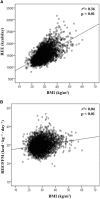Is Obesity Associated with Altered Energy Expenditure?
- PMID: 27184275
- PMCID: PMC4863259
- DOI: 10.3945/an.115.008755
Is Obesity Associated with Altered Energy Expenditure?
Abstract
Historically, obese individuals were believed to have lower energy expenditure (EE) rates than nonobese individuals (normal and overweight), which, in the long term, would contribute to a positive energy balance and subsequent weight gain. The aim of this review was to critically appraise studies that compared measures of EE and its components, resting EE (REE), activity EE (AEE), and diet-induced thermogenesis (DIT), in obese and nonobese adults to elucidate whether obesity is associated with altered EE. Contrary to popular belief, research has shown that obese individuals have higher absolute REE and total EE. When body composition (namely the metabolically active component, fat-free mass) is taken into account, these differences between obese and nonobese individuals disappear, suggesting that EE in obese individuals is not altered. However, an important question is whether AEE is lower in obese individuals because of a decrease in overall physical activity or because of less energy expended while performing physical activity. AEE and DIT could be reduced in obese individuals, mostly because of unhealthy behavior (low physical activity, higher intake of fat). However, the current evidence does not support the hypothesis that obesity is sustained by lower daily EE or REE. Future studies, comparing EE between obese and nonobese and assessing potential physiologic abnormalities in obese individuals, should be able to better answer the question of whether these individuals have altered energy metabolism.
Keywords: activity energy expenditure; diet-induced thermogenesis; energy expenditure; energy metabolism; obesity; resting energy expenditure.
© 2016 American Society for Nutrition.
Conflict of interest statement
Author disclosures: IP Carneiro, SA Elliott, M Siervo, R Padwal, S Bertoli, A Battezzati, and CM Prado, no conflicts of interest.
Figures


References
-
- World Health Organization. Obesity: preventing and managing the global epidemic. Report of a WHO consultation. World Health Organ Tech Rep Ser 2000;894:i–xii, 1–253. - PubMed
-
- Ng M, Fleming T, Robinson M, Thomson B, Graetz N, Margono C, Mullany EC, Biryukov S, Abbafati C, Abera SF, et al. . Global, regional, and national prevalence of overweight and obesity in children and adults during 1980–2013: a systematic analysis for the Global Burden of Disease Study 2013. Lancet 2014;384:766–81. - PMC - PubMed
-
- Perri MG, Nezu AM, McKelvey WF, Shermer RL, Renjilian DA, Viegener BJ. Relapse prevention training and problem-solving therapy in the long-term management of obesity. J Consult Clin Psychol 2001;69:722–6. - PubMed
-
- Roberts SB. Abnormalities of energy expenditure and the development of obesity. Obes Res 1995;3(3 Suppl 2):155s–63s. - PubMed
-
- Ravussin E, Lillioja S, Knowler WC, Christin L, Freymond D, Abbott WG, Boyce V, Howard BV, Bogardus C. Reduced rate of energy expenditure as a risk factor for body-weight gain. N Engl J Med 1988;318:467–72. - PubMed
Publication types
MeSH terms
Substances
LinkOut - more resources
Full Text Sources
Other Literature Sources
Medical

